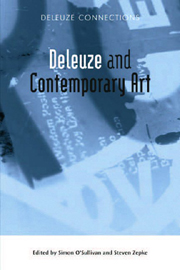Book contents
- Frontmatter
- Contents
- Acknowledgements
- List of Illustrations
- Introduction: Deleuze and Guattari and Contemporary Art
- POLITICS
- THE AESTHETIC PARADIGM
- SCENES AND ENCOUNTERS
- 9 An Art Scene as Big as the Ritz: The Logic of Scenes
- 10 Abstract Humour, Humorous Abstraction
- 11 From Aesthetics to the Abstract Machine: Deleuze, Guattari and Contemporary Art Practice
- 12 Traps Against Capture
- TECHNOLOGIES
- Notes on Contributors
- Index
11 - From Aesthetics to the Abstract Machine: Deleuze, Guattari and Contemporary Art Practice
from SCENES AND ENCOUNTERS
Published online by Cambridge University Press: 12 September 2012
- Frontmatter
- Contents
- Acknowledgements
- List of Illustrations
- Introduction: Deleuze and Guattari and Contemporary Art
- POLITICS
- THE AESTHETIC PARADIGM
- SCENES AND ENCOUNTERS
- 9 An Art Scene as Big as the Ritz: The Logic of Scenes
- 10 Abstract Humour, Humorous Abstraction
- 11 From Aesthetics to the Abstract Machine: Deleuze, Guattari and Contemporary Art Practice
- 12 Traps Against Capture
- TECHNOLOGIES
- Notes on Contributors
- Index
Summary
The following essay is in three inter-related parts. The first section introduces and attempts to think through a certain kind of contemporary art practice utilising what might loosely be called a Deleuzian framework (and via an argument that is in part made against Craig Owens and Nicolas Bourriaud). This section begins with an account of my encounter with a particular object and an art scene that contributed to my own rethinking about what the contemporary is and what it does. The second section revisits some of the points made in the first but is more explicit (and abstract) in its mobilisation of Deleuze's thought in that it takes concepts from across Deleuze and Deleuze and Guattari's corpus of work and brings them to bear on the field of contemporary art practice in general. The third brief and concluding section homes in on one particular concept and also turns to Guattari's solo writings in order to think a little more about what I take to be one of contemporary art's most important characteristics: its future orientation (and it is in this sense, ultimately, that contemporary art names not just a type of art, but art's very diagrammatic function).
Aesthetics and Art Practice
It seems to me that a new style – or attitude – has emerged in some of the contemporary art that has recently been exhibited in London and indeed elsewhere in Britain. A style that, I want to claim, has a certain resonance with Deleuze’s philosophy, and, as such, I want to use it as a personal and somewhat idiosyncratic ‘way in’ to think about the conjunction Deleuze and contemporary art.
- Type
- Chapter
- Information
- Deleuze and Contemporary Art , pp. 189 - 207Publisher: Edinburgh University PressPrint publication year: 2010



